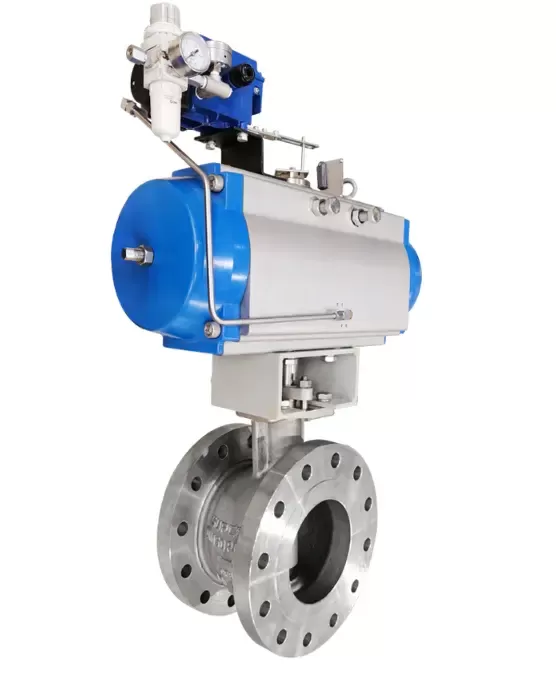Notifications

7 minutes, 11 seconds
-12 Views 0 Comments 0 Likes 0 Reviews

Introduction
Eccentric rotary China control valves are vital components in modern fluid control systems, offering precise regulation of gases and liquids across a wide range of industries. Unlike linear valves, they operate via a quarter-turn rotary motion (typically 90 degrees), enabling efficient flow modulation and reliable shutoff. Their rugged construction and adaptability make them ideal for applications ranging from simple isolation to demanding control in aggressive service environments.
This article examines the working principle, key design advantages, and performance benefits of eccentric rotary control valves, helping engineers understand their value in process automation and control.
An eccentric rotary control valve features a closure element—such as a disc or plug—mounted on a shaft that is offset from the valve’s centerline. This eccentric shaft design causes the closure element to swing away from the seat during opening, minimizing sliding contact and reducing wear. As the valve closes, the disc moves back into alignment with the seat, ensuring a tight, reliable seal.
This offset rotary motion enhances sealing performance, reduces friction, and extends operational life—especially important in abrasive or corrosive service conditions.
The valve’s control action is based on the rotational movement of the disc or plug:
Opening: The disc rotates away from the seat, avoiding direct sliding contact. This reduces wear and prevents galling.
Modulating: The angular position of the disc determines the flow rate, enabling precise control.
Closing: The disc swings back into position against the seat, guided by the eccentric path to achieve a tight shutoff.
This friction-minimizing rotary action significantly enhances valve longevity compared to traditional linear control valves.
Self-centering seat seal: Ensures automatic alignment with the disc during operation for consistent sealing.
Automatic lapping effect: The disc naturally conforms to the seat, improving tightness and sealing performance over time.
Protected bearings: Sealed bearings resist contamination from process media, enhancing operational stability.
These features ensure smooth performance, even in harsh and variable process conditions.
Eccentric motion: Reduces friction between disc and seat, lowering wear during opening/closing cycles.
Premium seat materials:
316 stainless steel
A105 forged carbon steel with welded carbide
Industrial ceramics
These materials provide resistance to corrosion, erosion, and thermal cycling. Reduced torque requirements also minimize stress on the actuator and mechanical components, extending valve life—particularly valuable in high-cycle or abrasive environments.
Flanged body design: Enables easy integration into standard piping systems.
Wafer (flangeless) design: Ideal for space-constrained or lightweight installations.
Concealed flange bolts: Enhance aesthetics and protect fasteners in corrosive environments.
Precision-machined valve bodies ensure proper alignment and tight sealing during installation.
Forward and reverse sealing: The valve seals effectively in either direction, offering flexible installation without flow orientation constraints.
Outlet protection: Reverse flow directs turbulence away from the seat, reducing erosion and extending seat life.
Quarter-turn efficiency: The 90° motion minimizes scouring and mechanical stress during rapid flow changes.
This bidirectional capability supports process flexibility and simplifies system design.
Thanks to their durability and control precision, eccentric rotary control valves are widely used in:
Chemical and Petrochemical Plants: Handling corrosive, abrasive, or high-temperature fluids with tight shutoff and accurate modulation.
Power Generation: Managing steam, water, and gas flows under high pressure and thermal load.
Water and Wastewater Treatment: Controlling large flow volumes with fluctuating pressure and particulate content.
Oil and Gas: Operating in upstream, midstream, and refining systems where reliability and resistance to wear are critical.
Pulp and Paper Processing: Withstanding abrasive slurries and high-cycle operation in harsh production environments.
Modern eccentric rotary valves can be equipped with a range of actuation systems and accessories for seamless integration into automated environments:
Manual gear operators for basic on-off control.
Electric actuators for integration with PLCs and remote control systems.
Pneumatic actuators for rapid, explosion-safe actuation in hazardous zones.
Positioners and feedback devices to support modulating control with real-time feedback.
Add-ons such as solenoids, limit switches, and air filters for advanced automation.
These options ensure the valve can meet specific operational and safety requirements across industries.
Eccentric rotary valves are designed for long-term performance with minimal maintenance:
Low operating torque: Reduces actuator load and energy use.
Minimal friction: Eccentric motion limits wear on critical surfaces.
Field-replaceable parts: Seats, seals, and actuators can be replaced in-line, minimizing downtime.
Simplified internal access: Speeds up maintenance routines and reduces labor costs.
Their modular construction supports fast servicing and ensures maximum uptime in critical systems.
Eccentric rotary control valves combine mechanical efficiency, sealing reliability, and robust construction into a compact, adaptable solution for modern fluid control challenges. Their offset rotary design reduces friction and wear, while advanced sealing technologies and bidirectional flow capability enhance system flexibility and performance.
With a wide range of material, actuation, and configuration options, these valves are suited for everything from light-duty installations to severe service environments. Whether for new builds or retrofits, incorporating eccentric rotary control valves can lead to improved reliability, lower maintenance costs, and optimized control in demanding industrial processes.Know more about Google SEO Directory

